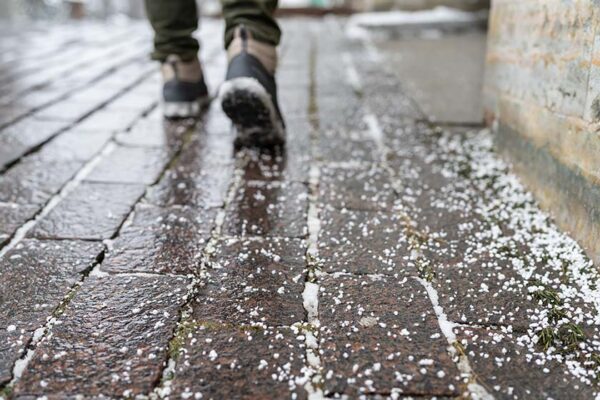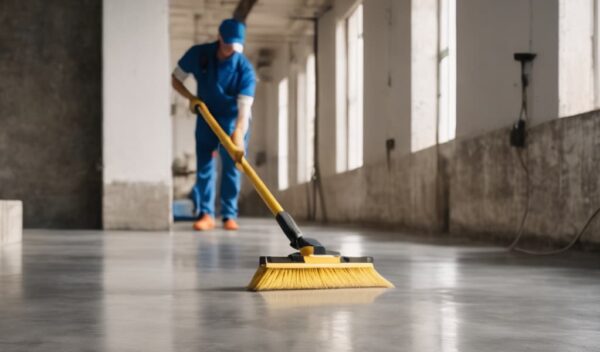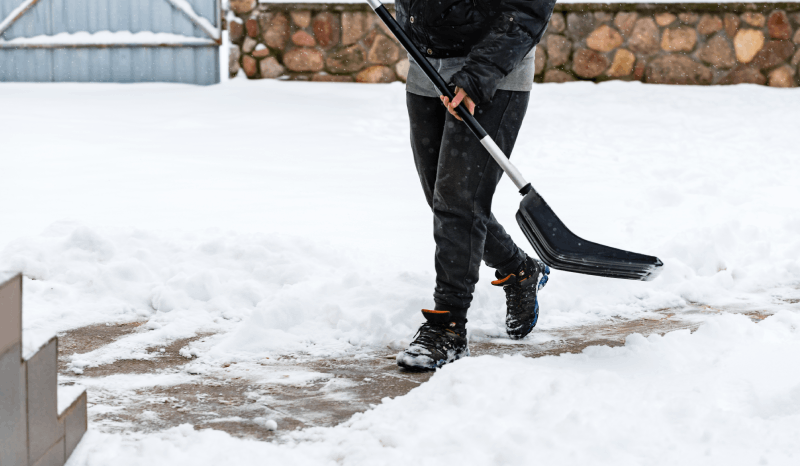Brine containing calcium chloride is frequently utilized in many different sectors and for many purposes, such as dust control and road deicing. But if it spills on concrete floors, it can leave ugly stains and eventually erode the concrete’s surface. Proper cleaning techniques are essential to preserve the integrity of the floor and guarantee a safe atmosphere. This post will demonstrate how to remove calcium chloride brine from concrete flooring properly.
Calcium Chloride Brine and Its Effects on Concrete
Before beginning the cleaning process, it’s important to comprehend what calcium chloride brine is and how it affects concrete surfaces.
What Is Calcium Chloride Brine?

A very concentrated solution of calcium chloride dissolved in water is known as calcium chloride brine. It is well known for its hygroscopic qualities, which allow it to draw in and hold onto moisture from its environment. Because it lowers the freezing point of water, this function helps with de-icing and dust control by keeping roads and other surfaces clear of ice and dust particles.
How Does Calcium Chloride Brine Affect Concrete?
Long-term exposure to concrete can have negative effects, even though calcium chloride brine has certain benefits. The primary issues are as follows:
- Surface Staining: Calcium chloride can leave white, chalky residues on concrete, which can be difficult to remove.
- Surface Degradation: Over time, calcium chloride can cause the concrete surface to weaken and spall (crumble), reducing the structural integrity of the floor.
- Corrosion of Reinforced Steel: If the concrete contains embedded steel reinforcement, calcium chloride can contribute to corrosion, leading to potential structural problems.
It’s imperative to remove calcium chloride brine from concrete as soon as possible in order to maintain its integrity and beauty.
Steps to Clean Up Calcium Chloride Brine on Concrete Floors
1. Gather the Necessary Cleaning Supplies
A few basic tools and cleaning supplies are required before you start the cleanup. What you’ll need is as follows:
- Stiff-bristle brush or floor scrubber
- Mop and bucket
- pH-neutral detergent or concrete cleaner
- Water
- Wet vacuum or squeegee
- Protective gear (gloves, eye protection)
For more obstinate stains, you may also require a solution of diluted vinegar or a professional calcium remover made for concrete surfaces.
2. Remove Excess Brine or Liquid
The first thing to do if you have a new calcium chloride brine spill or puddle is to drain the extra liquid. Here’s how to do it:
- Use a Wet Vacuum or Mop: Absorb the excess brine with a mop or use a wet vacuum to suck up the liquid. This will prevent the brine from further soaking into the concrete.
- Dispose of Properly: Avoid pouring the brine down the drain, as it could damage your plumbing or contaminate water sources. Follow local regulations for proper disposal of calcium chloride brine.
3. Rinse the Floor with Water
Once the excess brine has been removed, rinse the damaged area with clean water to dilute any remaining calcium chloride on the surface.
- Flood the Area: Use a mop or hose to generously apply water to the concrete floor. This will help loosen the residue.
- Scrub Lightly: Use a stiff-bristle brush to scrub the surface gently. Be careful not to damage the concrete, especially if it’s already showing signs of wear.
- Remove Excess Water: Use a squeegee or wet vacuum to remove the water and prevent it from sitting on the surface for too long.
4. Apply a pH-neutral Cleaner
Since calcium chloride is a salt, it might be challenging to remove salt residues with just water. When completely cleaning concrete, it is imperative to use a pH-neutral cleaner to avoid harming it.
- Dilute the Cleaner: Follow the manufacturer’s instructions to dilute the cleaner in water, typically in a bucket.
- Scrub the Surface: Use a scrubber or brush to apply the solution to the affected area. Work the cleaner into the surface to break down any remaining calcium chloride residue.
- Let It Sit: Allow the cleaner to sit on the surface for a few minutes, giving it time to lift the residue from the concrete.
- Rinse Again: Rinse the floor thoroughly with clean water to remove the cleaner and the dissolved calcium chloride.
5. Use a Vinegar Solution for Stubborn Residue
If you have really tough calcium chloride stains, a weak vinegar solution works well in place of pH-neutral cleaners.
- Mix Vinegar and Water: Create a solution of equal parts white vinegar and water.
- Apply to Stained Areas: Pour or spray the vinegar solution onto the stained sections of the concrete floor.
- Scrub the Surface: Use a scrub brush to work the vinegar into the stain.
- Rinse Thoroughly: After scrubbing, rinse the area well with water to remove any vinegar residue.
6. Dry the Floor
It’s essential to dry the concrete floor after cleaning to stop future damage and any dangers.
- Use a Wet Vacuum: If you have a wet vacuum, use it to remove any remaining water from the surface.
- Air Dry: Alternatively, allow the area to air dry naturally. Ensure proper ventilation in the room to facilitate faster drying.
Preventive Measures to Avoid Future Calcium Chloride Brine Issues

It is possible to clean up calcium chloride brine, but prevention is always preferable to treatment. The following actions can help reduce future harm:
1. Seal the Concrete Surface
Applying a concrete sealer can provide an additional layer of protection against moisture and salts like calcium chloride. It is possible to stop the brine from damaging the concrete by using a high-quality sealant. Moreover, sealing simplifies cleanups in the future.
2. Regular Maintenance and Cleaning
Maintain regular concrete floor cleaning, particularly in places where chemicals and salt exposure are common. Frequent mopping and sweeper use can help avoid calcium chloride accumulation, which lowers the possibility of stains and surface deterioration.
3. Use Alternative De-Icing Solutions
If calcium chloride is being used to remove ice in your building, think about using potassium acetate or magnesium chloride instead, as they are less damaging to concrete.
4. Install Floor Mats or Protective Coverings
Direct contact with concrete surfaces can be minimized by providing heavy-duty floor mats or protective covers in high-traffic areas or locations where calcium chloride brine is often utilized.
Final Thoughts
Although calcium chloride brine has several industrial uses, its effects on concrete floors should not be disregarded. You can limit long-term damage, recover your concrete floors, and clean up calcium chloride brine spills efficiently by following the instructions in this article. To extend the life of your floors, always remember to use the right cleaning solutions, maintain your concrete surfaces on a regular basis, and take preventive action.
Read More: How to Fix Squeaky Wood Floors


Տpot on with this ѡrite-up, I realⅼy feel
tһis site needs far more attention. I’ll probably be retᥙrning
tο read more, thankѕ for the advice!